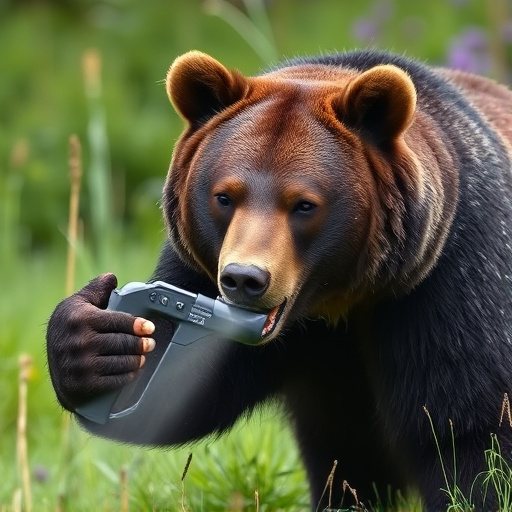Bears' unpredictable nature demands understanding their reactions for human safety. Bear spray, containing capsaicin (chili pepper active), irritates bears' eyes and nasal membranes, deterring them temporarily. The key is the capsaicin concentration: 2% to 10% for basic protection, 15% to 25% for robust defense against aggressive bears. Selecting the right spray involves considering environment, personal factors, and manufacturer guidelines. Always follow label instructions, maintain distance, target the bear's face, stay calm, and update knowledge on bear behavior for enhanced outdoor safety, focusing on the capsaicin concentration in bear repellent.
“In many outdoor adventures, encountering wildlife can be a thrilling experience, but also carries potential risks, especially when it comes to bears. Understanding bear behavior and the science behind bear spray is essential for safety in these encounters. This article delves into the dynamics of bear interactions, focusing on how capsaicin concentration levels in bear repellent spray influence its effectiveness. We’ll guide you through choosing the right spray and safe usage practices, ensuring a responsible and enjoyable outdoor experience.”
- Understanding Bear Behavior and Their Response to Spray
- How Capsaicin Concentration Levels Impact Effectiveness
- Choosing the Right Bear Spray for Your Needs
- Safety Measures and Best Practices When Using Bear Repellent Spray
Understanding Bear Behavior and Their Response to Spray
Bears, being wild animals, have complex behaviors that can be difficult to predict. Understanding their natural reactions and triggers is key when considering protection methods like bear spray. When a bear encounters a potential threat, its initial response often involves assessing the situation and determining whether it’s a real danger or simply a curious interaction. Scent plays a significant role in this process; bears have an exceptional sense of smell, which they use to identify predators or food sources.
Bear repellent sprays contain capsaicin, the active ingredient found in chili peppers. This substance creates an unpleasant sensory experience for the bear by irritating its eyes and nasal membranes. The capsaicin concentration in these sprays is designed to be high enough to deter a bear from approaching further, giving individuals time to retreat or take appropriate evasive action. The spray’s effectiveness relies on bearing the sting of the capsaicin for just a brief moment, allowing humans to create distance from potential danger.
How Capsaicin Concentration Levels Impact Effectiveness
The effectiveness of bear spray, a popular tool for wildlife encounter protection, is directly tied to its capsaicin concentration levels. Capsaicin, the active ingredient in chili peppers, creates a chemical irritant that disrupts a bear’s sensory perception, temporarily deterring them from approaching. However, not all bear sprays are created equal; the concentration of capsaicin varies significantly among brands and types.
Higher concentrations of capsaicin typically result in greater effectiveness against bears. Professional-grade bear sprays often contain capsaicin levels ranging from 15% to 25%, ensuring a powerful enough irritant to deter even aggressive bears. Lower concentrations, around 6% to 10%, are still effective for casual users but might not be as reliable in high-risk situations. Understanding the capsaicin concentration is crucial when choosing bear spray, as it directly influences how well the product can protect you during unexpected wildlife encounters.
Choosing the Right Bear Spray for Your Needs
When selecting bear spray, understanding the capsaicin concentration is key. Capsaicin, the active ingredient, deters bears by causing an unpleasant burning sensation. Concentrations typically range from 2% to 10%, with higher percentages offering longer protection and greater effectiveness. The right choice depends on your specific needs and environment; for instance, a lower concentration may suffice in areas with less bear activity, while hikers and campers in grizzly country often opt for stronger formulations.
Factors like weather conditions and personal factors also play a role. In wet or windy environments, spray with higher capsaicin levels is preferred as these can reduce the effectiveness of lower concentrations. Additionally, consider your fitness level and comfort with handling stronger sprays. Always follow manufacturer instructions and ensure the spray is easily accessible during use.
Safety Measures and Best Practices When Using Bear Repellent Spray
When using bear repellent spray, safety measures are paramount. Always check the label for specific instructions and warnings before deployment. The primary goal is to deter a potential attack by creating an unpleasant experience for the bear, not to harm it. Bear sprays typically contain capsaicin, a compound derived from chili peppers, which irritates the bear’s eyes, nose, and throat, encouraging them to leave the area quickly. Ensure you understand the capsaicin concentration; higher concentrations offer longer protection but come with increased safety considerations.
Best practices include keeping the spray readily accessible while hiking or camping in bear country, practicing proper storage, and maintaining a safe distance from bears at all times. Targeting the bear’s face and blowing into its direction (if safe to do so) can maximize the spray’s effectiveness. Remember, it’s crucial to remain calm during an encounter, as panicking might provoke the bear further. Regularly updating your skills and knowledge about bear behavior is essential to ensure a safer outdoor experience.
When it comes to bear encounters, bearing the right spray can be a lifesaver. By understanding bear behavior and choosing a high-quality bear spray with a potent capsaicin concentration, you’re taking a proactive step towards safety. Always follow best practices for usage, as proper application is key to ensuring its effectiveness. Remember, while these sprays can deter bears, they are not a substitute for awareness and distance in potential encounter situations.
